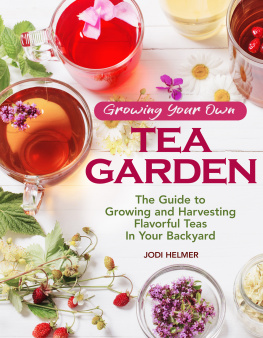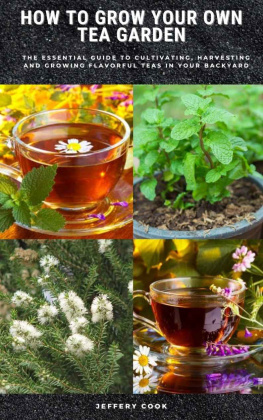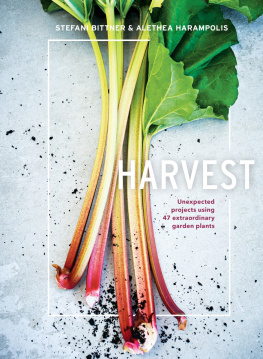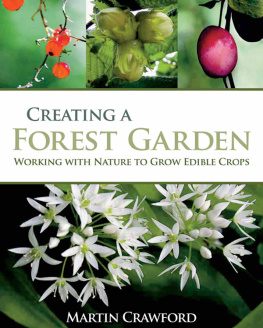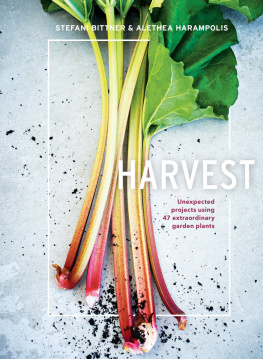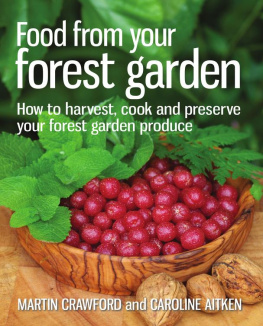
Growing Your Own
TEA
GARDEN
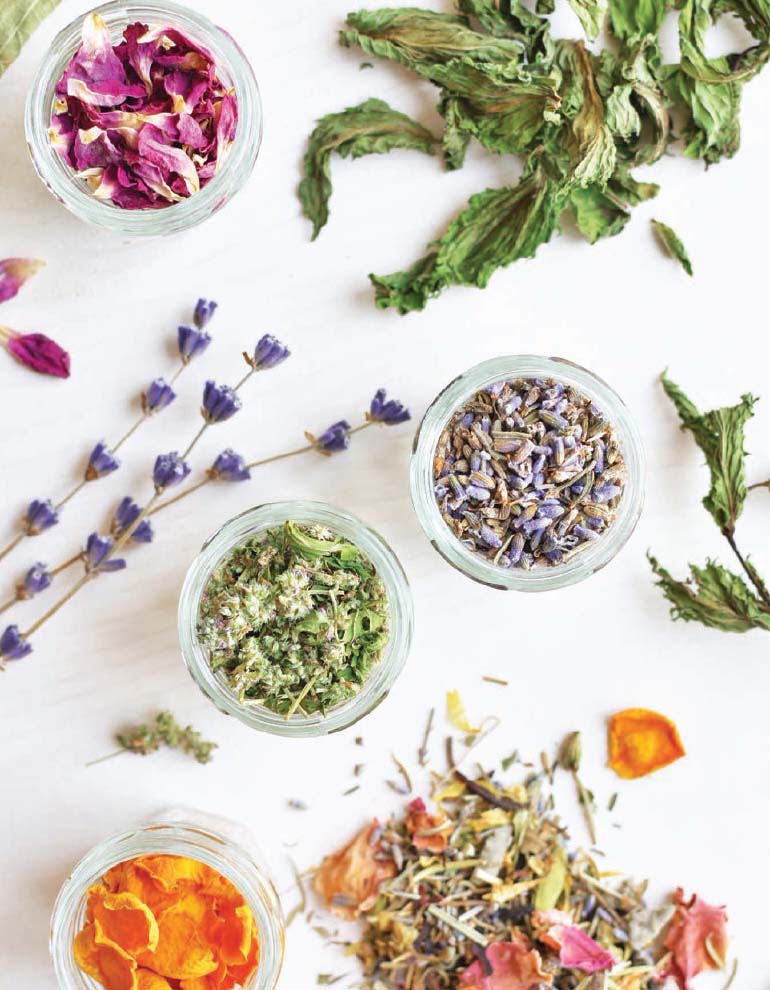
Growing Your Own
TEA
GARDEN
The Guide to Growing and Harvesting Flavorful Teas in Your Backyard
JODI HELMER
Growing Your Own Tea Garden
CompanionHouse Books is an imprint of Fox Chapel Publishers International Ltd.
Project Team
Vice PresidentContent: Christopher Reggio
Editor: Colleen Dorsey
Copy Editor: Katie Ocasio
Design: Llara Pazdan
Index: Jay Kreider
Copyright 2019 by Jodi Helmer and Fox Chapel Publishers International Ltd.
All rights reserved. No part of this book may be reproduced, stored in a retrieval system, or transmitted in any form or by any means, electronic, mechanical, photocopying, recording, or otherwise, without the prior written permission of Fox Chapel Publishers, except for the inclusion of brief quotations in an acknowledged review.
ISBN 978-1-62008-322-2
The Cataloging-in-Publication Data is on file with the Library of Congress.
This book has been published with the intent to provide accurate and authoritative information in regard to the subject matter within. While every precaution has been taken in the preparation of this book, the author and publisher expressly disclaim any responsibility for any errors, omissions, or adverse effects arising from the use or application of the information contained herein.

Fox Chapel Publishing
903 Square Street
Mount Joy, PA 17552 | Fox Chapel Publishers International Ltd.
7 Danefield Road, Selsey (Chichester)
West Sussex PO20 9DA, U.K. |
www.facebook.com/companionhousebooks
We are always looking for talented authors. To submit an idea, please send a brief inquiry to .
Printed and bound in Singapore
20 21 20 19 2 4 6 8 10 9 7 5 3 1

DEDICATION
For my late grandmother, Veronica Thomas, who always made sure the kettle was on.
ACKNOWLEDGMENTS
Writing a book is a lot like brewing the perfect cup of tea: it takes the right ingredients and enough time to steep.
Im grateful to Diane Daniel for introducing me to Bud Sperry at Fox Chapel Publishing and trusting good things would happen, and thankful that Bud believed in this idea and encouraged me to turn a passion into a manuscript. My dear friends Megan Bame, Heather Rice Books, Polly Campbell, Kate Hanley, Wendy Helfenbaum, Beth Howard, Kelly James, Judi Ketteler, and Rosie Molinary, and my family, Hank and Dianne Helmer, Shannon Helmer, and Charlotte McKinnon, supported me during the writing process.
My final and most heartfelt thanks is for my husband, Jerry, who is my favorite person to share a pot of tea with.
CONTENTS

PLANT INDEX
TEA (Camellia sinensis)
LEAVES
FLOWERS
FRUITS
ROOTS
INTRODUCTION
Some of my earliest and fondest childhood memories involve tea. My grandmother used to pour us each a cup of tea in her no-nonsense mugs, filling hers with steaming black liquid and a splash of milk, and preparing mine in reversea full cup of milk with just a splash of tea. Wed dunk homemade peanut butter cookies in our mugs and declare it a tea party.
While my tea preferences have changednow, I prefer a strong, bitter cup of black tea, no milk, first thing in the morning; mint tea in the evenings; and something sweet, floral, and iced when its sweltering outsidemy love affair with tea has endured (and I still enjoy the occasional tea party, especially one that includes a fancy hotel and finger sandwiches). There is something so soothing about a cup of teathe way its warmth transfers from the mug to your hands, how the scent of it is like aromatherapy, how a sip is both familiar and new, the way you can put together just the right variety to fit the mood or fix what ails you.
Despite being a lifelong tea drinker, it had never occurred to me to grow all of the ingredients to make my own tea. The inspiration hit three years ago at a garden center where, standing in front of vast metal racks filled with peppermint, spearmint, chamomile, lavender, and lemon balm, I thought, This looks a lot like the tea aisle at the supermarket. An image of a backyard tea garden flashed in my mind. Cue a cart filled with herbs and some bags of soil, and a few hours later I had all the makings of a great cup of tea right outside my back door. Every time I head outside to pick a fresh cup of tea, I remember my grandmother and feel a sense of gratitude for the continued comfort this ritual she taught me has brought me over the years.
This is the last time I saw my grandmother before she passed awayand she was enjoying a cup of tea, as always.
Judging from the explosion of options in the grocery store aisle, I know I am not the only one with affection for tea. Maybe you brew a cup of tea in the morning for a quick pick-me-up, use an herbal blend to ease digestive upset, or wind down with a steaming mug before bed. Maybe you host tea parties for the children in your life or your sewing circle or book club. Even if you are an old hand at growing tomatoes or herbs like basil and rosemary, it may not have ever occurred to you that your tea could come from your own yard, too. Instead of reaching into the cupboard for a supermarket tea bag, you can plant a tea garden and then enjoy clipping fresh herbs such as chamomile, lemon balm, basil, and peppermint for your own signature brews.
A tea garden provides instant access to fresh, flavorful herbs and allows you to get creative, mixing different plantings to create one-of-a-kind blends. And while it might seem daunting or fancy, growing the ingredients for tea is actually a great project for both beginners and experienced gardeners. Most herbs are easy to grow (most will thrive in pots on a sun-drenched windowsill), and making flavorful tea can be as simple as steeping a few freshly plucked leaves in boiling water or as complex as drying herbs and combining multiple ingredients to make custom brews. Whether youve never tended to a plant before or have a large garden and want a new hobby, starting a tea garden and sipping fresh, flavorful garden-to-teacup brews is a great way to embrace your fondness for this classic drink.
Disclaimer: This book is not a field guide; its not intended to diagnose, treat, or cure any disease. I am a gardener and tea drinker, not a doctor or nutritionist. Although I did extensive research to ensure accuracy, you must make sure to positively identify all plants before eating leaves, flowers, fruits, and roots. Some wild plants are poisonous or can have adverse effects. Avoid consuming any unfamiliar plants. Consult with qualified health professionals to verify the health benefits and safety of consuming plants.
Next page
